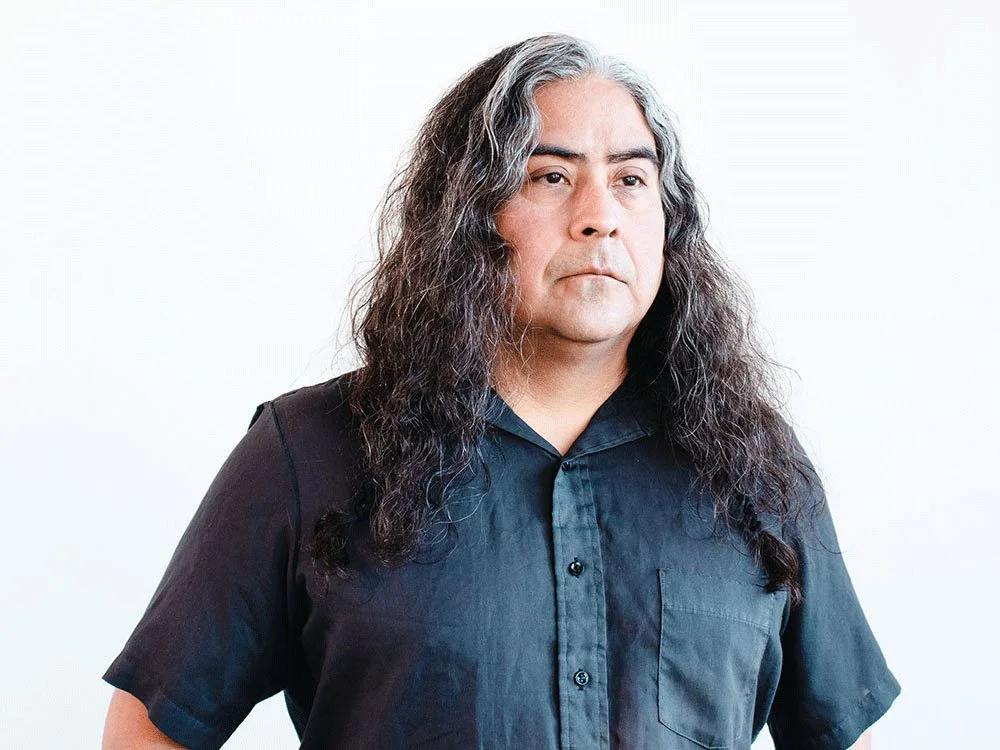Pulitzer Prize-winning Voiceless Mass repurposes working churches
Diné composer Raven Chacon’s revered piece is scored for chamber ensemble, pipe organ, and sine tones
Raven Chacon.
Vancouver New Music presents Voiceless Mass at Pacific Spirit United Church on November 18
EVERYONE’S A CRITIC, but most of us wait until after a performance before pronouncing judgement on what we’ve just heard. Not so the anonymous parishioner at Claremont, California’s United Church of Christ, who was all too ready to cast the first stone during Diné composer Raven Chacon’s presentation of his Voiceless Mass.
“That was a bit of a bizarre invitation,” Chacon notes in a Zoom call from upstate New York’s Bard College. “The United Church of Christ in Milwaukee, Wisconsin co-commissioned Voiceless Mass, and so the congregation in Claremont wanted to do the composition—and the church there had invited me to see if I was also interested in giving a sermon. I thought that was quite an honour, and they said ‘You could do it completely musical, as well.’ So I thought of a new piece for that occasion, just a quick five-minute composition that thanked the Mother, and tried to counter at least some of the language that gets used in the church, speaking about the one who created us being male.”
Despite the United Church of Christ’s reputation as a generally progressive body, Chacon’s electroacoustic invocation of the Divine Feminine within the house of the Holy Father did not sit well with the aforementioned zealot.
“A gentleman walked out midway through,” the composer relates. “He told everybody they were going to Hell for listening to my sermon, grabbed his wife and kids, and left.
“So that’s all good,” he adds, not without a trace of amusement.
If anything, the outburst simply made the remaining listeners even more attentive—and judging by recent developments, that one rude fundamentalist has been outvoted many, many times over. Last year, Voiceless Mass won the Pulitzer Prize for distinguished musical composition, and in October of this year the MacArthur Foundation awarded Chacon a US$800,000 “genius grant” to pursue his singular path.
Much of what Chacon does—from noise-guitar improvisations to nuanced string-quartet scores to multimedia collaborations with visual artists—asks for close attention, with a subtext of inserting a Navajo worldview into contemporary artistic discourse. Voiceless Mass is no exception: scored for chamber ensemble, pipe organ, and sine tones, it is specifically meant to be played in working churches, with the intent of repurposing these colonial edifices as containers for deep reflection on the church’s subjugation of Indigenous populations worldwide. And from that directive, perhaps some form of dialogue can start.
In his program notes for Voiceless Mass, Chacon admitted to some skepticism regarding art’s ability to effect change. The work, he wrote, “considers the futility of giving voice to the voiceless, when ceding space is never an option for those in power”.
He’s feeling somewhat less futile these days.
“You know, when I wrote that—definitely before the piece premiered, and definitely before it won the Pulitzer—I was thinking of this gesture of giving opportunity for voice within some of these institutions,” he says now. “And so I was thinking about, of course, the church, but I was also thinking about institutions where they’re claiming to make space for a diversity of voices, or voices that are going to address history, and yet there’s no action behind those gestures….Part of that comes from the frustration of, like, land acknowledgements. You know, speaking about that acknowledgement without actually giving over the space.
“I don’t necessarily mean actually handing over the keys to the building or the church, but I think it becomes futile when it ends there,” he continues. “And the beautiful thing, or the thing that I’m proud that this piece has achieved, is that there’s some beginning of that conversation every time it gets presented. It has to be performed in a church, so it brings audiences to the scene of the crime, I suppose. But at least that’s a step in acknowledging this. We’re not speaking about it from afar. We’re not in a classroom. We’re not on the written page. We’re actually in that space, seeing the building in all its glory, and having to place this piece of music inside of it.”
When Vancouver New Music presents Voiceless Mass at Pacific Spirit United Church on Saturday (November 18), it will be accompanied by another work of Chacon’s, …lahgo adil’i dine doo yeehosinilgii yidaaghi. The title, which translates as “acting strangely or differently in the company of strangers”, makes oblique reference to the way that some critics and musicians have inserted a stereotypical kind of “Indigeneity” into the composer’s work, which is anything but. The score itself pays homage to a key piece of European avant-gardism, British composer and activist Cornelius Cardew’s 1967 graphic score Treatise, and to the First Nations rock art around Albuquerque, New Mexico.
“Of course, nobody can top Treatise,” Chacon allows. “That’s what, 200 pages or so of music? But I wanted to make a score that was a nod to Treatise, and I needed a good reason to convince myself to do such a thing. So I’d been making these drawings that were this kind of hybrid notation, I suppose; they were drawings that were influenced by two things, growing up in the Southwest. One was these petroglyphs carved into volcanic rocks on the west side of Albuquerque, these drawings that are a thousand years old done by the people who are the ancestors of the Pueblo tribes and also of my tribe, the Diné. So I would make my own versions of them, and I would start combining these with other things I would see, particularly in Santa Fe and in some cheap curio shops around Albuquerque. You see a lot of fake Native American art, or at least things that maybe are more for the tourist gaze, and I started to draw those, too.
“And so I had these symbols that I had been accumulating—drawing them on paper, drawing them on napkins, drawing them on receipts—and around the same time I was going to CalArts, and I had a variety of teachers or maybe other composers that I would study with, and they would ask me this question: they would say ‘Am I supposed to be hearing Navajo music in your work?’ And I would say ‘I don’t think so. Maybe. I believe you’ll hear every music I’ve ever listened to in my life in these compositions. You’ll hear Slayer! You’ll hear Iron Maiden. You’ll hear the Beatles. You’ll hear Alvin Lucier, maybe. I believe you’ll hear everything in there.’ But I kept getting this question, and it was starting to frustrate me. So I thought ‘Well, what if I made a piece that was like Treatise, and this composition had no instructions, no key explaining what these symbols mean, and it became the burden of the musicians who took on the composition to conjure this Indigenous music that other people are asking me about.’”
It was not an entirely successful experiment. Chacon initially published the score as a free download which, he says, led to some distressing interpretations. “People were doing that in a way I was not anticipating,” he explains. “They were doing the stereotypical pentatonic scales and four-beat Indianesque Hollywood soundtrack music, because they thought that that was what I wanted and that was their own assumption of what Navajo music was.
“So I had to cut that out right away,” he adds. “That was having the inverse effect of what I was hoping to achieve, and what I was hoping to achieve was to find some kind of sonic reference to the place that I was writing from: amongst those rocks in the volcano, or where the volcano had scattered these rocks. If there was such a way to make the soundtrack to that place with chamber instruments, that’s what I was hoping to achieve.”
Between direct input from Chacon and the all-star cast that Vancouver New Music artistic director Giorgio Magnanensi has assembled for next Saturday’s performance, that should be an attainable goal—and no clichés need apply.













